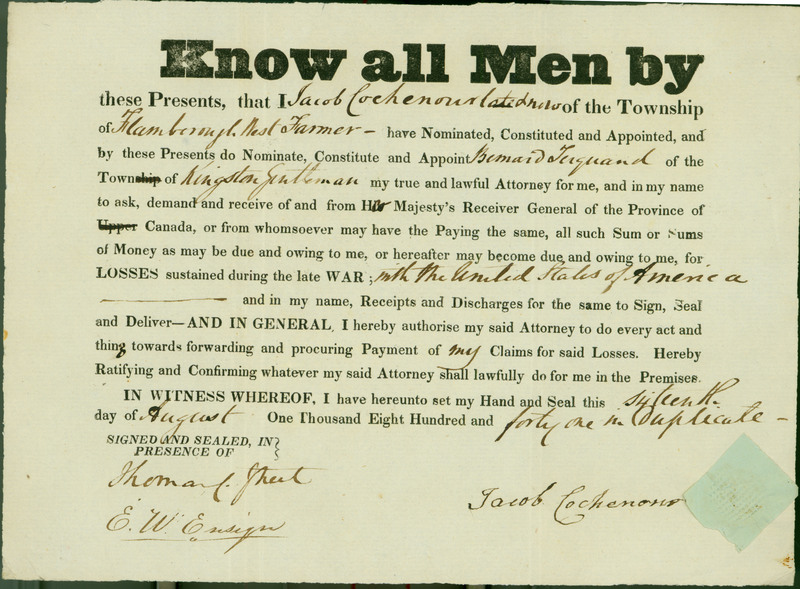Legal Documents
Statutes of his Majesty's Province in Upper Canada, 1812
These statutes outline the recruitment, administration, and discipline of the militia. Isaac Brock's name appears on the cover. He was the President of Upper Canada at the time.
RG 400 The Statutes of his Majesty's Province in Upper Canada, Sir Isaac Brock, 1812
Ancaster Treason Trials
The declaration of war in 1812 brought into question the loyalty of the colony's population, who were largely born in America. As concerns over allegiance intensified the government sought out traitors in an attempt to make an example of them and deter others. The subsequent trials of citizens accused of treason resulted in 15 convictions. These trials were intended to assert the authority of the state, but also to demonstrate clemency. These trials became commonly known as the Ancaster Bloody Assize of 1814. Only eight of the convicts were executed, with the rest being banished from the colony.
Copies of the Ancaster Trial proceedings and letters between Secretary General Drummond and Thomas Scott (Chief Justice of Upper Canada) provide further details of the trials.
RG 276 Ancaster Treason Trials proceedings
RG 414 Letters to Secretary General Drummond from Thomas Scott, July 1814
Financial Claims
War Loss Claims
Citizens would petition the government for financial compensation due to damage to their property as a result of the war. Jacob Cochenour, of the Township of Flamborough West, submitted a claim to the government in 1841 for losses sustained during the war.
RG 406 Jacob Cochenour's War Loss claim
Widow's Pensions
For those killed during the War of 1812, pensions were sometimes awarded to the surviving spouse. Such was the case with Matthias Saunders. Matthias was a shipbuilder who was responsible for two ships during the War of 1812, the Prince Regent and Sir Isaac Brock. During an attack on the Town of York by General Dearborn, a powder magazine exploded and Saunders suffered irreparable damage to his legs and died. His wife Elizabeth received a widow's pension at the rate of 20 pounds per annum.
RG 687 Warrant for widow's pension for Elizabeth Saunders, 1815
Daniel McDougall pension statement, 1824
The document is an order by Sir Peregrine Maitland, Lieutenant Governor of Upper Canada, to the Hon. John Henry Dunn, Receiver General of Upper Canada, to pay Lieutenant Daniel McDougall £33, 15 shillings, half year pension, for his service in the Militia. The document notes that McDougall was “disabled by several wounds received in action with the Enemy at Lundy’s Lane on the 25th July 1814…”
RG 744 Daniel McDougall pension statement, 1824
Pay Warrant
The document is an order from Gordon Drummond, President administering the Province of Upper Canada, to John McGill, Receiver General of Upper Canada, directing him to pay McDonell, the Deputy Paymaster of the General Militia, 288 pounds, eleven shillings and six pence Halifax Currency, equal to 269 pounds, six shillings and nine pence army sterling. The money is to enable him to pay the officers, non-commissioned officers, and privates of the incorporated militia. The document is singed at Kingston, March 22, 1815, and is signed by Gordon Drummond, President, and Robert H. Loring, Secretary.
RG 745 Alexander McDonell warrant to pay the incorporated Militia, 1815
Land Grants
Those who served during the war of 1812 were sometimes rewarded for their service with land grants from the government. A military land grant to Richard Leonard in 1818 gave him 200 acres of land in the Township of Sidney. Leonard was a member of the 104th Regiment of the British Army. The Regiment was based in New Brunswick but marched to Kingston (and two flank companies to Niagara) during the winter of 1813 to reinforce troops there. He fought at Sackett's Harbour, Lundy's Lane and Fort Erie. After the war he settled at Lundy's Lane and was appointed lieutenant colonel of the 1st Militia. He later became the Sheriff of Niagara.
RG 671 Richard Leonard land grant, 1818

